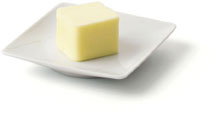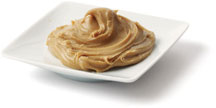CHAPTER 7
Fats and Oils
The difference is as clear as day and night, heaven and hell, Red Sox and Yankees.
On one side are the “bad” fats: saturated fats and trans fats. Saturated fats—often solid at room temperature—are the fats found in animal foods: meat, poultry, dairy and eggs. To be fair, some vegetable products—palm oil, for example—also contain saturated fats. These fats raise total and LDL cholesterol levels, which is harmful to heart health, and burden insulin receptors, which raises the risk of diabetes.
Trans fats, which start as liquids and are solidified through the process of hydrogenation, also raise LDL cholesterol levels. In addition, they lower the level of HDL cholesterol, decrease the body’s ability to burn fat and raise the levels of C-reactive protein—a marker for inflammation. Trans fats extend the shelf life of many commercial food products; they’re found in vegetable shortenings and margarines, crackers, cookies, processed pastries, snack foods and—famously—such fried foods as french fries. And as we’ve noted, 25 percent of the vegetables eaten in the United States are french fries!
THE HEALTH STUDY PENDULUM
For a long time, we were told butter, a saturated fat, was bad for us, so we should all put margarine on our bread—a vegetable fat considered a healthy substitute.
Enter trans fats! The popular thinking changed again. Since many margarines are high in trans fats, we would all be better off going back to butter.
But the numbers tell a different story. In general, margarine contains 11 percent saturated fat and 1 percent trans fat, while butter contains 40 percent saturated fat and 5 percent trans fat. So even the worst of margarines is probably not as harmful as butter—especially if you’re trying to lose weight or fight diabetes.
Recently, many margarine manufacturers, eager to be able to proclaim “no trans fat” on their packaging, have substituted palm oil for the hydrogenated oil in the margarine. True, palm oil has no trans fat, but it’s very high in saturated fat.
Margarine guidelines? Look for products listing vegetable oil—preferably canola or olive—as their first ingredient. Also, a soft tub margarine rather than a solid stick is usually a better bet. Moreover, several light margarines on the market offer considerably fewer calories than regular margarine. In cooking, olive oil or canola oil is always preferable to any margarine.
And assume that the pendulum won’t swing back.
While cholesterol is not a fat, it plays on the Bad Fats team. That is because it often occurs together with fat in all animal products, and although this dietary cholesterol does not raise blood cholesterol as much as do saturated and trans fats, it raises it somewhat. Moreover, it works synergistically with saturated fat; that is, a food that has both saturated fat and cholesterol will raise blood cholesterol to a greater degree and with more impact than a food that does not. Shrimp, for example, has virtually no fat, but it does have cholesterol. Salmon, by contrast, has both cholesterol and fat, but not saturated fat. Neither will have nearly as much of an impact on blood cholesterol as a steak, a cheese omelet or a side order of bacon.
On the other side of the line is Team Good Fats, comprising monounsaturated and polyunsaturated fats and omega-3 fatty acids. These good fats do exactly the opposite of what the bad fats do—and more. Healthful fats lower cholesterol and may decrease insulin resistance. In addition, the omega-3s lower triglycerides, raise HDL cholesterol, lower blood pressure and can help prevent blood clotting. They boost the level of leptin, the hormone that helps regulate appetite and metabolism, and they stimulate the body’s fat-burning mechanism. They can even help keep glucose intolerance from turning into full-blown type 2 diabetes.
THE CHALLENGE
All fats, good and bad, represent a very concentrated source of calories—approximately 100 to 125 calories per tablespoon. That doesn’t mean you should avoid the good fats. The main reason fats and oils occupy such a small rung of the Beat Diabetes Pyramid is not their calorie count; it’s because in general, fats and oils represent a smaller portion of the overall diet than other foods. Their primary role is really to flavor foods and enhance their appeal.
Fat is crucial to the functioning of the body—especially for skin, hair, blood and brain—and, as you remember from Chapter 1, it offers substantive benefits for weight loss and for beating diabetes. So we must take in fats; in fact, certain fatty acids are labeled essential because they are not made by the body and must therefore be obtained through food.
The challenge, therefore, is to balance your intake of fats so you get enough of the weight loss and diabetes-fighting benefits while avoiding a calorie intake that could jeopardize those very benefits.
Fortunately, by following the guidelines of the Beat Diabetes Pyramid, you should be able easily to achieve the right balance.
How? Guideline 1
Note the team players in the fats and oils rung of the Pyramid:
- Canola, flax and olive oils
- All nuts and seeds and their butters and oils
- Olives
- Avocado
All of these contain good fats. Basically, we’re talking about oils for cooking and for use in dressings and dips; about snack foods—nuts, seeds, olives; and about the basis of guacamole, avocado, also a salad food.
A NUTTY REPLACEMENT
A transatlantic study on almonds and cholesterol found not only that almonds helped maintain a healthy cholesterol level without weight gain but also that study participants found the nuts sufficiently filling that they used them to replace other foods. Over a period of ten weeks, study participants neither gained weight nor increased their body fat—nor did they increase the amount of food they were eating.
In addition, levels of vitamin E and magnesium were up in the study participants, a direct effect of the intake of almonds.
How Much? Guideline 2
The fact is that as a general rule, we usually don’t eat a huge volume of fat or oil. In that respect, the foods on the fats and oils rung are typical; none of them represents anything like high-volume eating. We might use a tablespoon or two of the oils at any one time, munch a handful of nuts, seeds or olives and enjoy avocado as an appetizer, side dish or light lunch. But that’s about it. The amount of these fats we take in tends to be basically modest relative to other food groups.
And that’s pretty much all that’s needed to get the benefits of the Beat Diabetes fats and oils. A good amount of omega-3s per day, for example, would be from 1 to 3 grams—especially if you have or are at risk for high blood pressure or high triglycerides. Where can you find 3 grams of omega-3s? A single tablespoon of flaxseeds provides just that amount; sprinkle it on a salad, fruit or pretty much anything else. One tablespoon of flax oil, by contrast, contains 7 grams of omega-3s, so a single teaspoon of flax oil on your salad would do the trick.
In fact, try this quick and easy recipe for sesame-flax dressing—worthy of a Good Fat award.
SESAME-FLAX DRESSING
1. Put the ingredients together in a jar.
2. Refrigerate, then shake again before using.
The recipe makes ten 2-tablespoon servings at 90 calories per serving.
¼ cup toasted sesame oil
¼ cup flax oil
¼ cup vinegar
¼ cup water
¼ cup prepared mustard
2 packets of Splenda
¼–½ teaspoon salt
Pepper to taste.
Don’t forget that every tablespoon of oil, no matter what kind, costs 100 to 125 calories. So while you might be using olive oil, for example, to replace a bad fat, the fact that it is a good fat should not be license to slather it extravagantly over everything.
OLIVE OIL PREMIUM
It’s called squalene, and a study has shown that it lowers LDL cholesterol. Patients participating in the study took squalene supplements for five months and enjoyed a 22 percent decline in their LDL cholesterol count. But olive oil contains squalene naturally, so just by substituting it for butter, you may be lowering your bad cholesterol.
Another study suggests that extra-virgin olive oil may even go one step further than refined olive oil, protecting against LDL cholesterol oxidation.
This cholesterol-lowering power makes olive oil a highly rewarding good fat.
How to split the difference? Follow the mantra used throughout this book: let your appetite and sense of satiety be your guide. Where the oils for cooking are concerned, use the amount you need to enhance the flavor of other foods on the Pyramid; in a salad or dressing, use enough to satisfy your taste. Enjoy that handful of nuts, seeds or olives, and if one avocado half isn’t enough, by all means have the other.
Here’s the bottom line: an eating plan that contains fairly liberal amounts of the good fats but is restricted in refined carbohydrates is good for both diabetes control and weight loss. The Beat Diabetes Pyramid is such an eating plan, so where the good fats are concerned, be a liberal, not a conservative.
DIPS AND DRESSINGS
Here are examples of appetizer dips, salad dressings and side dishes, lined up as bad fats versus good. Check out the calorie differences in these particular dips and dressings—with no sacrifice of taste.
Bad Fats

Good Fats

So the first guideline for making sure you get the benefits of needed fats and oils without the high-calorie impact is to use these foods as replacements for others. In other words, sauté your vegetables with canola oil, not butter. Snack on nuts and olives rather than cheese and crackers. Toss some slices of avocado in your salad along with other ingredients to get the benefits of good fats along with the vegetable benefits—and maybe save some calories by using a light or reduced-fat dressing.
GOOD FAT/BAD FAT
Here’s the good fat vs. bad fat story in a nutshell—to be specific, a peanut shell:
On the left, 2 tablespoons of butter. It’s not a huge amount, yet the butter contains 220 calories and 24 grams of fat—indicated as 5 pats of butter. And butter is mainly saturated fat; it raises your cholesterol and has no redeeming health benefits.
On the right, an equivalent amount of peanut butter: 2 tablespoons. The peanut butter contains fewer calories (190) and less fat (16 grams, represented as 3 teaspoons of oil) than the butter. But this fat is mainly monounsaturated, so it may actually lower your cholesterol. Moreover, it contains such vitamin and mineral nutrients as vitamin E, niacin, phosphorus and magnesium.
End of story.


2 tablespoons butter
220 calories
24 grams fat
5 pats butter
vs.


2 tablespoons peanut butter
190 calories
16 grams fat
3 teaspoons oil